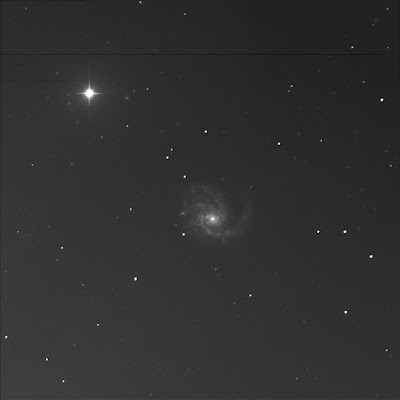Knowing it was well-placed, I asked (back on 29 Apr) the Burke-Gaffney Observatory to collect some photons.
Messier 99 (Coma Pinwheel, NGC 4254) is located in the constellation Coma Berenices near the bright star HD 107170 (SAO 100039, HIP 60089). Commonly referred to as St. Katherine's Wheel.
Luminance only, 60 seconds subexposures, 10 stacked shots. FITS Liberator, Paint. North is up; east is left.
I looked at the weather conditions. The CSC chart showed cloud: 20%; ECMWF: cloud 79%; trans: average; seeing: average 3/5. The Moon altitude was 23% in a full phase! Stoopid Moon. Washing out the scene. Unfortunate timing. Still, that might mean this a more representative view through the eyepiece in a modest telescope.
I see a lovely face-on spiral galaxy with a medium-bright large core. The arms are quite interesting and everything seems a little askew with the galactic core off-centre, shifted to the south. The arm to the south seems solitary, isolated. It must be a barred core! Feels like the arm to the north is fanning westward dragging along smaller arms and additional structure.
Within the arms, fascinating detail, dense versus loose regions. Wow. Star-making regions, large nebulae.
This would be really wonderful in a dark sky in a big aperture in a nice ocular.
§
I wouldn't have known it but SkyTools 4 shows two small faint galaxies near the star. I can see LEDA 165065 to the west, a small round fuzzy dot. The one to the east, curiously, I cannot detect, even though ST4 shows it as a bit larger.
Almost due north of M99, I can see another round fuzzy, LEDA 169040, about level with the mag 13.7 star J121851.4+143016.
Just east of 169040, I can see LEDA 169043. Small appearance. Fuzzy, small, almost perfectly round.
Due east of M99, further afield, is LEDA 165069. A very faint almond, canted north-south.
North-east of St. Katherine's, also a good distance away, south of the star, is LEDA 165066. Slightly larger and brighter than all these other round fuzzies.
Stars visible in the magnitude 16 to 17 range.
§
Nice little treat.
§
Pre-processed again in FITS Lib
I should not have used the Scaled Peak Level feature. Left it at 10 this time, versus 100. Increasing this does not seem a good idea with a moonlit sky.
That southern arm in the galaxy is more apparent. It's crazy long! It wraps all the way the western side and starts to curve around the top.
Really interesting the empty void between the arm and main part of the spiral. Empty.




2 comments:
What is a “ barred core”? I don’t know that term.
The central core of spiral galaxies seem to come in a couple of flavours. The two main ones I know are "regular" for lack of a better term and "barred."
A regular core is just a spherical ball shape. I believe the early impression of our galaxy was that it had a spherical galactic bulge and you'll see many renderings drawing or illustrated that way. Perhaps flattened but still a ball shape. These types of galaxies seem to have multiple arms, spinning out. A bit like those rotating fireworks wheels. NGC 5457 is a very good example.
But another core type is barred. Here are rod-like shape lies in the central region of the galaxy, lies flat or in-line with the disc. From the two ends of the rod or bar, two main arms of the galactic emerge and propagate. Often these galaxies seem to have two prominent arms only, like the two-bladed screw or propeller on a boat. NGC 1300 exemplifies the structure.
Hope that helps.
Post a Comment